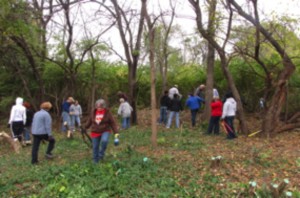
Volunteers with implements of destruction spread out into the honeysuckle. Photo by Forest Park Forever.
By Amy Redfield
Wielding bypass loppers, hacksaws, anvil loppers, and Japanese saws, Wild Ones members wreaked havoc amongst the tangle of honeysuckle. Trunks as thick as a foot across (are we really sure honeysuckle is a shrub and not a tree??) gave way under the onslaught, only to have their stumps painted with herbicide so the roots will die as well. These fearsome mauraders joined forces with over 75 volunteers on a cool November Saturday as part of a Honeysuckle Removal Project, pooling efforts to cut, treat, and remove honeysuckle from approximately one and a half acres in Forest Park. En route to the removal site, they passed the efforts of last year’s work, which allowed sunlight to reach the forest floor and awaken native seeds left dormant from the pervasive honeysuckle shade.
Since almost four more acres are still infested with this brawny invasive that chokes out natives and changes the ecology of the woodland, more work parties are planned for next fall, so you too can join in the fun.
- Kathy and Brian plot the next move in the battle.
- Fran drags honeysuckle carcasses to the wood chipper.
- Alex cuts a particularly large honeysuckle down to size.
- Alex wrestles stubborn honeysuckle into submission.
- Brian’s trusty yellow hacksaw makes quick(ish) work of a honeysuckle limb.
- Glenda cuts a honeysuckle off at the base while Amy gives a helping hand.
Thanks to Ed Schmidt for the great action photos!

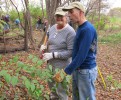

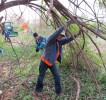
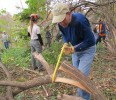
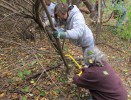

What a vigorous write-up! What great photos!
I was glad to see elderberry canes where we cleared bush honeysuckle in Forest Park. In my area, I’ve watched honeysuckle decimate a large, healthy population of elderberries. Let’s take back the forest, the roadsides, our backyards …!
My thanks go to Amy for facilitating Wild Ones members’ participation in this group endeavor to eradicate bush honeysuckle. I was very happy to learn the proper concentration of Round-Up (20%) that is necessary to really kill this plant.
Although I am very grateful to Forest Park Forever staff for having the foresight and initiative to address this huge ecological problem, I thought there were a number of ways the organization of the event could have been improved upon. Since my professional life has been spent as a teacher in private schools (Waldorf Schools), we as the faculty routinely critiqued every open house and festival to see what worked and how we could make it even better in the future.
I had deep concerns about safety issues around this event and I thought we were fortunate to have no injuries. The chippers were VERY noisy and very close to where we were working and this noise level made it difficult to communicate with each other and also caused me to put up my sensory guard in an effort to reduce the sensory overload. This made me less aware of my surroundings and I realized at one point that I was cutting a bush that would have fallen on Brian! Fortunately, I stopped in time and Brian was safe but I think with this many people in a small area, we need to be hyper-aware of each other and our surroundings.
Another concern was the weakness in the realm of training. It was wonderful that so many people showed up but many had no experience and were cutting everything in sight which was distressing to me. The staff were engaged in keeping people a safe distance away from the chipper instead of supervising the work. Also, extra tools that I brought were borrowed without permission in the general chaos which was another distress. Fortunately, they were recovered later but I felt it was an unnecessary element.
In an effort to recover my missing tools, I went to the Forest Park Forever office on Monday and had a very positive conversation with Anne Grossmann about some of my concerns. I was tactful and appreciative of her efforts and also shared my concerns. She was very open to receiving evaluation of the event and said some other people had left early because they also felt it was not safe. She said that this year’s event was in a much smaller area and that in other years people were more spread out and further away from the chipper and each other.
I thought that if the cutting could be done with hand tools initially, there would be a space for conversation and communion with nature as we worked. I also felt that each group of newcomers could have used an experienced person to help them. She agreed and asked if Wild Ones members might be willing to act in this capacity for future events. Then, when the bulk of the cutting was complete, most people could leave and a few hardy souls could drag the bushes to the chippers for phase 2 of the operation.
Of course, they may use or not use my suggestions but I am always seeking to find ways to help people have a positive experience with nature and my hope was that we could work on the honeysuckle AND have a peaceful experience simultaneously. I have been working on my property for five years with only hand tools and so of course I see this other way of taking out the honeysuckle. I must end this comment with deep compliments to Alex for his enthusiasm and hard work. Very impressive!
How exciting, Glenda! Thank you so much for bringing your thoughts and ideas to the organizers. I am thrilled that they were so responsive. I love the idea about pairing Wild Ones members with other volunteers so that they are doing things correctly. I would love to do that!
I can attest to the possible dangers of working with lots of enthusiastic but untrained volunteers. A couple of years ago, I walked into a stump that was cut too high and gouged my shin so severely that I needed stitches. And the worst part was that I was the one who had left the stump! Some of the bushes are quite large, and difficult to cut with a hacksaw. I’m glad that Forest Park staff have been coming through with a chainsaw during the morning to cut stumps closer to the ground.
I cringe a little when I see people cutting plants other than honeysuckle too. However, the areas where the public honeysuckle removal has been done are so overgrown that there’s not much else. The most important first step is to clear the area so that Forest Park staff can come through in the months and years to come to remove any new honeysuckle and other invasive plants. Even if people cut native plants, the increased sunlight and water will allow new plants to grow.
It’s difficult to coordinate 100+ enthusiastic but untrained volunteers, and I think Forest Park Forever has done a good job. I’ve been helping with the honeysuckle removal project for 5 years, and it’s been very rewarding. I like the feeling of accomplishment on the work day, and I enjoy returning to areas where we’ve worked to see them gradually return to native vegetation. I suspect that Forest Park is one of the largest local areas that is mostly free of bush honeysuckle. I’m glad to have helped, and I look forward to next year’s project.
I agree such an operation can be dangerous. I tripped several times over the stumps we left behind. The only thing kept me going is my dislike of bush honeysuckle.
I like Glenda’s idea of having the chippers come later. The noise was disorienting and harmful to our ears. If I do this again next year I will leave my own tools at home.
Thanks everyone for your input.
Kathy Bildner